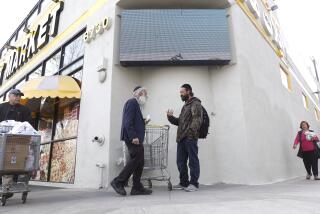A Meeting of Past and Present : Jewish Historical Society’s Tour Shows That South L.A. Synagogues Live On
Fifty years ago, the neighborhood east of La Brea Avenue and Adams Boulevard was awash in the sound of Yiddish and Big-Band swing, and Les Leibson loved it.
As a boy of 10, Leibson would dash through throngs of shoppers along Adams to pick up pastrami cold cuts at his aunt’s delicatessen or Russian rye bread at nearby Weitz Bakery.
Not far from his Hebrew school, the Bard Theater’s flashing neon marquee drew hundreds nightly, and the strawberry malteds at Flexo’s pharmacy a few blocks from his house were not to be missed.
“It was a bustling, thriving neighborhood back then,” the 61-year-old Leibson recalled recently as he walked up the boulevard of his childhood. “I was fortunate to have been a part of it.”
At the time, his neighborhood and a few others across south Los Angeles were home to about 40,000 Jews. Although nearly all have moved on, they left an indelible stamp on the area. The theater is boarded up and the pharmacy is now a carniceria , or meat market, but a handful of unassuming former synagogues stand witness to a bygone era.
There are at least seven in south Los Angeles, and all have been converted into Christian churches. Despite this, many have retained the Hebrew inscriptions and stars of David that symbolized their original use.
They are now the focus of an effort to keep alive accounts of the area’s Jewish past through a bus tour sponsored by the Jewish Historical Society of Southern California.
The organization has conducted similar tours of synagogues located in Boyle Heights and Downtown Los Angeles for the past 15 years. But earlier this month, 45 curious society members boarded a chartered Santa Monica Blue Bus for the first tour of temple sites in south Los Angeles. The excursion lasted nearly six hours and included stops in Mid-City and Venice.
Among the participants was Dianne Morris, a UCLA graduate student in architecture who had seen pictures of the synagogues-turned-churches along the tour route but had never visited them.
“It was really interesting to see an old synagogue presently being used in one instance by a Baptist community, and to see that very little had been modified,” she said.
The site that so impressed Morris was the Greater New Vision Missionary Baptist Church on Martin Luther King Jr. Boulevard that had been built in 1931 for a congregation of Sephardic Jews. Sephardic refers to the descendants of Jews who were expelled or fled from Spain during the Inquisition of the late 1400s.
Their domed and clay-tiled structure on King remained a temple until as late as 1975.
But despite its conversion, large Hebrew writing remains etched above the building’s main entrance. And at least two stained-glass stars of David continue to bathe worshipers in the main hall with rays of diffused light.
“It’s a beautiful building; we’re trying to keep it as it was originally,” said Pastor Lucious Pope, who welcomed the tour into the church to connect with the past. “We think it has history, we think it has significance. We have nothing against the Jewish faith.”
Indeed, historical society Vice President Jerry Freedman Habush said that many Christian congregations using former synagogues readily acknowledge their churches’ history despite the theological gap between the religions.
Pastor Warren Campbell, senior minister of the Second African Methodist Episcopal Church at Hoover and 55th streets, said the wrought-iron stars of David worked into the railings of his building’s lobby recall the Old Testament roots of Christianity. “They don’t offend me,” he said. “David was a great patriarch of the Bible.”
Campbell has only been pastor for three years, but the church has been at the location since 1958. “I guess [the Jewish symbols] didn’t bother the old-timers either,” Campbell said. “If they did, why did they keep them?”
By the time Second A.M.E. Church had settled at the site of the former temple, most Jews had left south Los Angeles in search of newer, more modern suburbs to the west--repeating a demographic trend that brought them to the area in the first place.
In the 1920s and ‘30s, Habush explained, Jews began leaving the crowded, aging communities of Boyle Heights and Temple-Beaudry and gradually settled in cleaner, more spacious neighborhoods in South-Central, Jefferson Park and West Adams. The area, in fact, was at one time home to the largest Sephardic Jewish population on the West Coast, Habush said.
“Some people are surprised to hear there were Jews in south Los Angeles, but there were,” said Habush, who researched the history of the communities and served as guide for the bus tour.
Leibson, now a Hollywood resident, said he took the tour not so much for the history but for the opportunity to revisit locations where he attended weddings, dances and other memorable events.
“It’s always great to come back here,” he said, standing at the corner of Adams and Buckingham Road. “It was my home.”
More to Read
Sign up for Essential California
The most important California stories and recommendations in your inbox every morning.
You may occasionally receive promotional content from the Los Angeles Times.









